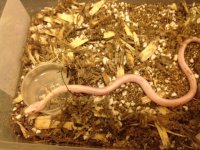LauRuffian
Perpetual Newbie
Greetings, all. My name is Laura, and I've had Cleo, the run-o-the-mill-regular-variety corn snake, as a classroom pet since she was 2 weeks old. She will be 10 next month.
She has always been kept in isolation, never exposed to any other snakes. Out of nowhere, she laid 5-6 eggs a year ago spring. It completely vexed me, but I likened it to a chicken laying infertile eggs and after keeping the eggs for a little while for the "Ooh, neat!" (and "Ew, neat!") factor in the classroom. Some Googling shocked me as I learned about parthenogenesis. A female kept in isolation her entire life? Check. More common in corns? Check. Huh. Maaybe...but no.
Fast forward to this year. Cleo once again has laid eggs--at first, it was 5-6 eggs in about 2 weeks, like she did last year. However, in the last 24 hours, she has laid an additional 11 eggs...and some are obvious yellow slugs, and some are bright white and make me wonder.
Here she is this evening guarding her "clutch"--you can see some eggs are whiter than others.

She also has refused to eat--she of eternal appetite--for the last 3-4 weeks.
Jussssssssssst in case I am experiencing the lightning strike of parthenogenesis, how do I keep the fertile-looking eggs so they have a chance to hatch? How can I check them to see if they *will* hatch?
She has always been kept in isolation, never exposed to any other snakes. Out of nowhere, she laid 5-6 eggs a year ago spring. It completely vexed me, but I likened it to a chicken laying infertile eggs and after keeping the eggs for a little while for the "Ooh, neat!" (and "Ew, neat!") factor in the classroom. Some Googling shocked me as I learned about parthenogenesis. A female kept in isolation her entire life? Check. More common in corns? Check. Huh. Maaybe...but no.
Fast forward to this year. Cleo once again has laid eggs--at first, it was 5-6 eggs in about 2 weeks, like she did last year. However, in the last 24 hours, she has laid an additional 11 eggs...and some are obvious yellow slugs, and some are bright white and make me wonder.
Here she is this evening guarding her "clutch"--you can see some eggs are whiter than others.

She also has refused to eat--she of eternal appetite--for the last 3-4 weeks.
Jussssssssssst in case I am experiencing the lightning strike of parthenogenesis, how do I keep the fertile-looking eggs so they have a chance to hatch? How can I check them to see if they *will* hatch?

